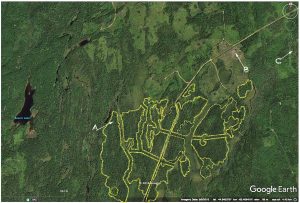 In January, I made use of stats on the National Forestry Database to address three questions:
In January, I made use of stats on the National Forestry Database to address three questions:
– Has clearcutting on Crown land in Nova Scotia increased or decreased? (Posted Jan 22, 2017)
– What’s a clearcut and what’s not a clearcut in Nova Scotia? (Posted Jan 23, 2017)
– How much forestry in Nova Scotia maintains mixed, multi-aged Acadian forest? (Posted Jan 23, 2017)
In those posts, I looked at stats for the years 2000, 2010 and 2014, 2014 being the most recent year available. Since then, figures for 2015 have been posted on the National Forestry Database. I have updated the summary tables accordingly (below) and added a table (Table 4) showing the the totals for all harvest types:
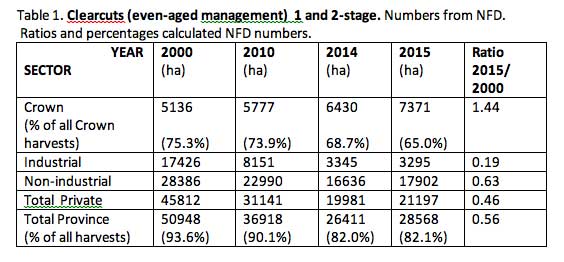
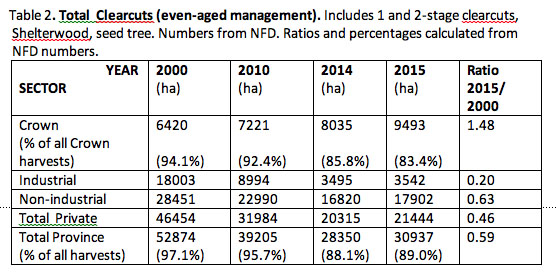
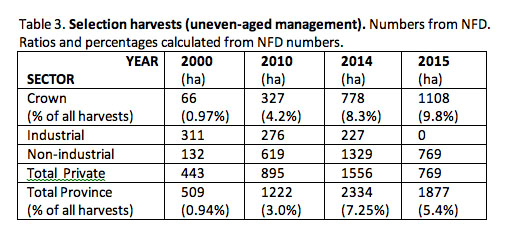
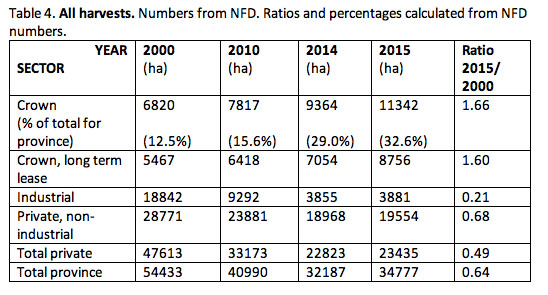
What really stand out are the increases in total area of Crown lands harvested between 2000 and 2014, while the area of private land harvested declined and total harvests for the province declined (view Table 4 above). The trend of increases in Crown land area harvested continued into 2015; on private lands, there was a small increase in total area harvested 2014 to 2015, breaking the trend of decline in earlier years.
It seems that Crown lands have come under increasing harvest pressure since 2000 relative to private lands and that trend continued into 2015.
To make full sense of the numbers, we would need figures on the working land area in the different categories over the same years and on forest age classes.
‘Time for the overdue State of the Forest Report with the complete numbers! The last State of the Forest Report was in 2008; the next one was scheduled for Feb. 2013 but has not yet appeared.
ADDENDUM (May 15, 2017)
I have only recently seen an article by Jennifer Henderson, March 30, 2017 in the Halifax Examiner: Losing the forests for the trees: New figures show increase in clearcutting, which reports on some the same figures comparing 2014 and 2015 that I cite above. A couple of points of interest noted by Henderson:
“The 2015 figures continue to show a growing percentage of timber coming from crown lands. In 2015, the percentage of wood from crown lands grew from a quarter to nearly one-third of the total area cut (11,342 hectares of 34,777 total)” and the explanation from Bruce Nunn (NSDNR):“This has to do with the change in ownership of the Bowater land,” explains DNR’s Nunn. “Bowater land use to be under the ‘Industrial’ category (meaning privately owned land managed by a forestry industry company), but since the province bought the land, it is now under the “Crown” category. The data shows that the increase in Crown harvest coincides with a decrease in Industrial harvest. The total amount of clearcutting across these two categories (Crown and Industrial) has remained fairly stable.” She gives figures cited by Nunn.
I was well aware of the Bowater purchases but had assumed that while some harvesting on those lands continued after the 2012 purchases (re: South Panuke), large cutting did not start on those lands until early 2016; see Nova Scotia mill group set to begin cutting on huge tract of Crown land (CBC Nov 5, 2015), but evidently it had. It would be helpful to see more numbers from NSDNR, i.e., illustrating precisely how much of the increased harvest on Crown lands 2000-2010, 2010-2014/2015 was on new lands acquired from NSDNR, and how much, if any, was due to more of the existing Crown land being cut.
There is also an interesting comment cited in Henderson’s article on how NSDNR views shelterwood cuts: “Shelterwood is a form of cutting that usually leaves behind 50 per cent or more of the biggest, oldest trees to provide shade and to regenerate a single species (e.g. red spruce). Once that species is established, the remaining mature trees are cut down.
The National Forestry Base considers this “a two-stage clearcut” (in effect, mature trees left standing will inevitably be cut). Bruce Nunn of the provincial Department of Natural Resources says the province does not view it this way. Instead, it considers shelterwood as “similar to a selection cut,” and excludes it when calculating clearcuts. In 2015, shelterwood accounted for 1,900 hectares that were not included in the province’s lower clearcut percentages — for both crown land and the province as a whole.”
View Jennifer Henderson’s article for more details.
Thanks Jennifer for your thorough research for this article!

